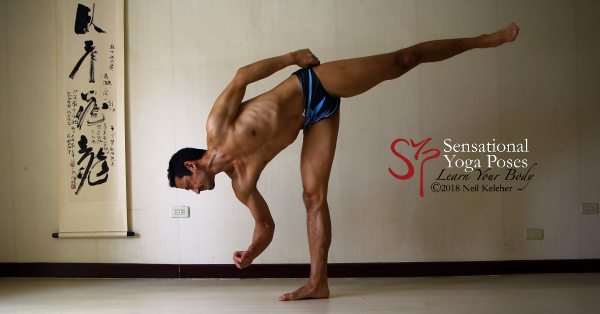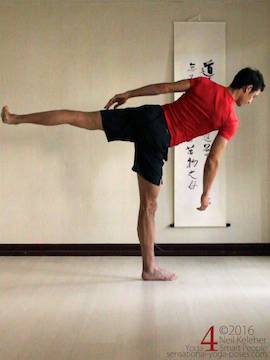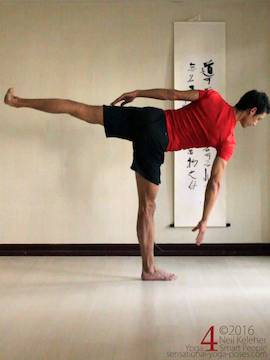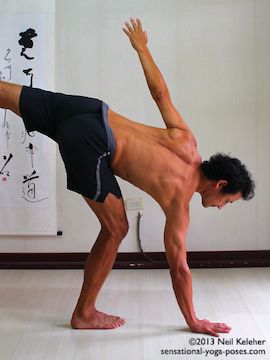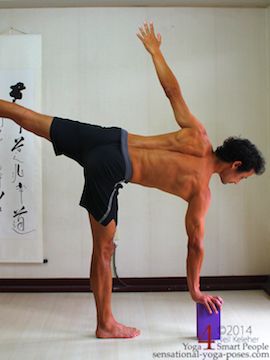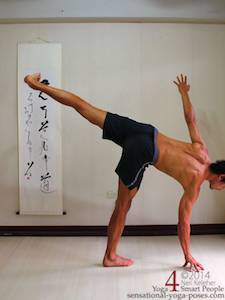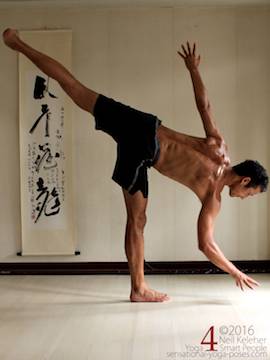Balancing in Half Moon Pose
Weight Shifting and Creating Stability for Better Balance
A lot of times prior to teaching students how to balance in half moon, I have them practice activating their feet and ankles.
That means making them stable!
In a yoga pose like half moon, because the foundation is so small it can be very helpful to make it as stable as possible.
To give your foot and ankle a rest in half moon pose, you can shift your weight towards your hand and use your arm to take some of the load.
With your hand on the floor and supporting some of your weight you actually make your foundation a little bit larger!
Half moon is a challenging balance pose because the foot is turned out relative to your pelvis.
However, you can counter this limitation by being aware of your hip joints and your pelvis.
Shifting Your Center of Gravity
Especially when first learning to balance on one foot, I'd suggest shifting your weight towards the front of your supporting foot so that your toes will naturally press down.
In addition make the foot and ankle "strong" so that it is easier to stay balanced.
With the hand on the floor it can be easy to relax the foot. If you wish to lift the hand, I'd suggest stabilizing the foot first.
Press the toes down and restablize foot and ankle, then lift your hand.
When standing up from the pose, try to keep your weight towards the front of your foot so that your toes continue to press down even as you return to upright.
Moving Into Half Moon Yoga Pose Step-by-Step
First turn your right foot out 90 degrees.
Shift weight onto your right foot and as you do so activate the foot and ankle. Shift far enough to the right so that your toes press down. Then lift your left foot.
If you find that your leg is wobbly despite your feet and ankles being strong, focus on keeping your knee and shin pointing to the side (in the same direction as your foot) and push your inner thigh forwards (in the same direction as your foot is pointing.)
Do this while keeping your foot stable.
Try to roll the left side of your pelvis backwards so that your pelvis faces the front. To do this try using the outer hip muscles of your right (supporting) leg.
With your pelvis facing the front you can work at lifting your lifted leg higher.
By actively lifting your lifted leg higher you can strengthen the outer thigh and hip of the lifted leg.
Touching the Hand to the Floor in Half Moon Yoga Pose
To touch your hand to the floor you may find it helps to bend your knee a little. You may also find it helpful, at least initially to use a yoga block.
If using a yoga block, see if you can gradually reduce the height of the block (turn it) till you can touch your hand to the floor.
Once you touch your hand to the floor you can work at gradually straightening your knee.
Shifting Your Weight in Half Moon Pose
Once your hand is on the floor in half moon yoga pose you can practice shifting your weight.
- Move your pelvis towards your supporting hand.
- Move your pelvis away from your supporting hand (but not too far!)
As you shift towards your hand notice how your hand presses down with increased pressure.
As you shift away from your hand notice how your hand pressure relaxes.
Adding a Hand Lift
Once you are used to shifting your weight you can add a hand lift.
Shift your weight towards your foot. Then stabilize your foot and ankle. Your hand should be relaxed at this stage. If it isn't then shift further (away from your hand).
Lift your hand by bending your elbow.
Pause for a few seconds (or work towards pausing for a few seconds). Then place your hand back on the floor again.
Repeat a few times on the same side, then switch sides.
After a few repetitions see if you can stand slowly and smoothly, in full control.
Published: 2011 04 04
Updated: 2018 03 30
